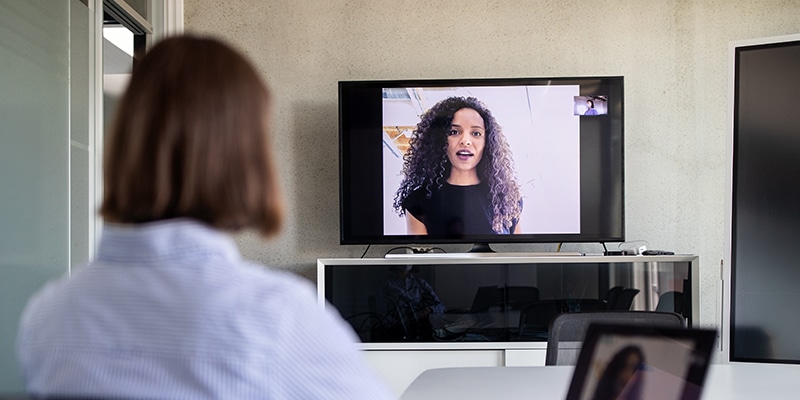MED-EL
Published Sep 20, 2021
Aural Rehabilitation via Telepractice: Current Practices and Future Outlook

Whether it’s for hearing aids, cochlear implants, or other hearing technology, it’s well-established and widely acknowledged that aural rehabilitation is absolutely essential for supporting better communication outcomes.
In past years, telepractice—remote rehabilitation via video chat—had gained some traction, but there was still limited uptake. However, over the past 18 months, there has been exponential growth of remote learning and telepractice due to the COVID-19 pandemic.
Today, we are excited to discuss the key learnings from a recent research project from two MED-EL employees, Rebecca Claridge and Nicholas Kroll. This telepractice research was recently added to the WHO list of COVID-19 literature resources.
Then, we’ll look at an upcoming telepractice research project with their colleague Natalie Teakle, and how you can join in and contribute to this research today.
Evolution of Telepractice During COVID-19
Rebecca Claridge: I was invited to present at the Asia Pacific Symposium on Cochlear Implants (APSCI) to be held in Tokyo in November 2019. The theme of the symposia was Remote Rehabilitation.
In preparing the topic, I reflected on the success of MED-EL Lesson Kits, a printable resource created for face-to-face aural rehabilitation. We had received such positive feedback from clinicians on the original lesson kits. As the creator of these kits, I believed that they could be modified for use in remote rehabilitation (telepractice).
Research at that time was reporting that clinicians continued to express reservations about telepractice despite encouraging outcomes. Barriers, such as internet connectivity issues, behaviour management, lack of confidence, and access to training and appropriate therapy resources were cited as challenges. So I hoped that by creating a specific resource for use in telepractice some of these factors could be ameliorated.
At APSCI, in November 2019, I presented the data from our study under preparation that demonstrated the success of distributing the original Lesson Kits therapy resources via social media and the MED-EL Professionals Blog. I explained that we planned to share these new “Remote Lesson Kits” in the same manner, but we also wanted to offer early access to clinicians who would be interested in completing a pair of surveys to share their telepractice experiences.
Nicholas Kroll: In collaborating with Rebecca, what I was immediately interested in was the infrastructure of sharing this knowledge. My goal is always to see how we can share these resources most effectively, and how we can increase the reach and impact of rehabilitation resources. In the end, materials are only helpful to people who can find them.
Back then, I saw this was a great opportunity to measure the effectiveness of digital distribution channels and to also take a deeper look into the promising “future” topic of telepractice. When we designed the surveys, we had expected a quite limited response, maybe 10–20 participants. After all, in late 2019, telepractice just wasn’t an area of focus for many practitioners.
Our surveys asked a wide range of questions, including experience in telepractice, confidence and perceived effectiveness, and potential barriers to access.
Once respondents answered the first survey, they would then receive the first two Remote Lesson Kits. These new lesson kits hadn’t been published yet, and they offered more than 100+ pages of professional guidance for telepractice rehabilitation sessions, so we hoped for at least some interest in this niche topic.
We planned to send out the first survey in mid-February 2020.
Rebecca Claridge: So you know what is coming of course.
On 18th of February, 2020, we shared the invitation to opt into the research through LinkedIn and to MED-EL Professional Blog subscribers. Respondents were emailed a link to our first survey and upon completion were emailed the first two remote lesson kits. For sharing with colleagues, participants were encouraged to share the link to the survey rather than just sharing the Remote Lesson Kits.
Over the coming weeks, as the pandemic exploded behind us and lockdowns spread, our participant numbers snowballed.
Nicholas Kroll: I got notified by email each time a survey was completed. I thought my inbox was going to crash, there was just a constant stream of notifications pouring in.
Rebecca Claridge: We ended up with more than 270 respondents to the first survey. Professionals from more than 40 countries shared their experience and opinions on telepractice. For the second survey, sent to the respondents in May 2020, we received 109 responses from clinicians in 29 countries.
The overall timing of the research gave us a unique opportunity to study changes in practice and perceptions as lockdowns and restrictions rapidly evolved in the first half of 2020.
Key Findings
We’re happy to say that the paper was published in the International Journal of Telerehabilitation and is freely available as an open access article:
We hope you’ll take the time to read through the article, but we also wanted to give you a quick summary of some of the key findings.
Telepractice Experience
For the first survey, the respondents were clinicians who were very experienced in delivering in-person aural rehabilitation. However, most had never tried telepractice.
But by the time of the second survey in May 2020, 91 % of responders had delivered telepractice, which is indeed a dramatic increase.
Confidence in Telepractice
In the first survey, respondents were equally likely to agree (35.2%) or to disagree (35.5%) with the statement:
“I feel as confident delivering intervention via telepractice as a I do with in-person lessons”.
Notably, clinicians with at least 1 year of experience in telepractice were much more likely to report feeling confident in telepractice.
What we found very interesting was a strong correlation between using the Remote Lesson Kits at least once a week and higher levels of confidence in telepractice.
Also, most clinicians with at least 1 year of telepractice experience reported that “therapy outcomes from telepractice are likely to be the same as in-person sessions.”
This is a promising result showing that—with telepractice experience—many clinicians do perceive telepractice as providing comparably beneficial outcomes.
Barriers to Telepractice
We asked the clinicians to rate different factors as barriers to telepractice delivery. We also asked how much of a positive impact they felt the Remote Lesson Kits had on those factors.
The top 5 factors were:
- “internet connectivity” (72.2% report “very significant” or “significant” impact)
- “child management” (72.0%)
- “clinician use of parent coaching strategies” (70.3%)
- “clinician’s experience in telepractice” (65.6%)
- “accessing or developing appropriate therapy resources” (65.6%)
Consistent with other studies, both experienced and inexperienced telepractioners reported “connectivity issues” as a major barrier. Hopefully improving consumer technology and access to high-speed internet and video calling apps will help overcome this obstacle.
We were very happy to see the Remote Lesson Kits had a positive impact on many of the factors—our goal with these free kits was always to support professionals as much as possible.
Take-Home Messages
Rebecca Claridge: What I liked most about being involved in this study was the feeling that we were helping clinicians when they needed it most. Our numbers were high because people were out there looking for support to work out how they could continue to provide a service to families who needed it at a time when the whole world was uncertain. I received many lovely emails from our study participants explaining how they were using the kits and these messages came in from all over the world.
Nicholas Kroll: It’s so meaningful to see how much of an impact these resources have made. The perspectives of all these clinicians have been very helpful for steering our development of materials and improving distribution channels. Every survey response helped build a bigger and more complete picture of what’s happening in the field. I really want to thank all the clinicians for taking the time to share their knowledge and experiences.
Rebecca Claridge: Well, I think by now just about every clinician in our field in the world has given telepractice a try.
The important message we learnt from our study is that confidence in telepractice grows quickly, so keep trying, even if it wasn’t perfect the first time.
Whether you’re still a beginner or already quite experienced in telepractice, using the Remote Lesson Kits can be really helpful because all the resources and directions are already prepared there for you. They’ve been tried and tested and are effective. Finally, we really recommend focusing on honing your parent-coaching techniques. This was a strong message from the confident and experienced clinicians.
And on the topic of parent coaching: This is something we are going to explore more in our next study. I’ll turn over to my colleague Natalie Teakle to introduce you to our exciting next phase in this research project.
Coaching Strategies: Join Our Research
Natalie Teakle: As we all know by now, effective telepractice isn’t achieved by simply moving our face-to-face therapy sessions to Zoom calls. It just doesn’t work! Telepractice requires different materials, techniques, skills, and roles for those involved and relies even more heavily on a clinician’s caregiver coaching for intervention to be effective.
We know that caregiver involvement in their child’s intervention has a significant impact on a child’s outcomes in early intervention. This involvement contributes to the caregiver’s knowledge, competence, and confidence in developing their child’s communication skills. As clinicians, we aim to develop these characteristics in caregivers by providing coaching. Whether it be in face-to-face or telepractice intervention, this coaching through the use of explanation, demonstration, collaborative working and discussion allows caregivers to practice and gain feedback.
That is why in our current study, we aim to delve further into the ongoing impact of the pandemic and sudden uptake of telepractice on clinicians’ caregiver coaching and their provision of intervention. We also aim to explore changes in clinicians’ confidence, thoughts, and attitudes towards telepractice during this time.
With this in mind, we would value your contribution to gather a global perspective of the current trends in telepractice & aural rehabilitation.
So today, we would like to invite you to participate in our next round of research surveys, starting right now. This survey takes approximately 10 minutes. If you are a professional providing aural rehabilitation, we would greatly appreciate your perspective.
There are no wrong answers, so we really hope you take the time to participate. By sharing your experiences, you personally are helping to provide a more comprehensive and well-rounded perspective of the current state and future needs of aural rehabilitation. We will utilize this research to support the ongoing development of essential rehabilitation resources.
On completion of the survey, you will have the opportunity to download a new telepractice resource developed in response to the feedback gathered in our first study.
You can take the survey here: Current Trends in Telepractice & Aural Rehabilitation: Professional Perspective
Subscribe & Share
You can find all the free Remote Lesson Kits here: Remote Lesson Kits
We also have more than 30 free Themed Lesson Kits for children and adults: Themed Lesson Kits
Don’t forget to subscribe for all the latest article from the MED-EL Professionals Blog.
MED-EL
Was this article helpful?
Thanks for your feedback.
Sign up for newsletter below for more.
Thanks for your feedback.
Please leave your message below.
CTA Form Success Message
Send us a message
Field is required
John Doe
Field is required
name@mail.com
Field is required
What do you think?
MED-EL







